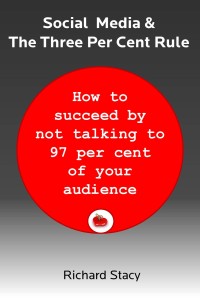 Is it possible that organisations such as Procter & Gamble and Coca-Cola (and even Facebook) are headed in the wrong direction when it comes to working out social media? Instead, could the very fact that such organisations are so accomplished in the practices of traditional marketing, mean that they are inhibited from developing an effective response in this new social media space? Could it be that this new space is not really a media space at all? Could it be that the idea of ‘reaching out’ and creating ‘engagement’ with consumers is a total waste of money and that value in the social digital space is created in an altogether different way?
Is it possible that organisations such as Procter & Gamble and Coca-Cola (and even Facebook) are headed in the wrong direction when it comes to working out social media? Instead, could the very fact that such organisations are so accomplished in the practices of traditional marketing, mean that they are inhibited from developing an effective response in this new social media space? Could it be that this new space is not really a media space at all? Could it be that the idea of ‘reaching out’ and creating ‘engagement’ with consumers is a total waste of money and that value in the social digital space is created in an altogether different way?
These ideas and many others are explored in an e.book I have just published called ‘Social Media and The Three Per Cent Rule: how to succeed by not talking to 97 per cent of your audience‘. Central to the book is the idea that traditional marketing is an activity designed for audiences because the media it has always worked with is an audience-based media. The reason media is audience-based (mass media) is because it is expensive. Social media is free. It has liberated information (content) from an expensive means of distribution and this has also liberated marketing from the need to talk to audiences. In fact it has created a requirement for all organisations to understand how to create cost effective relationships by talking to individuals or small groups. However, very few organisations have grasped this, preferring to see the challenge as that of building audiences within the social digital space, so that audience-based approaches can continue to work. This is because they have become wedded to audience-based relationships and are supported in this marriage by an entire industry which therefore has an interest it wants to preserve.
There are now two worlds: the world of the audience and the world of the individual. One world is not going to replace the other; rather organisations have to work out how to operate in both worlds at the same time, because consumers, customers and citizens have no problem doing this. And organisations cannot operate in the world of the individual by treating individuals as very small audiences, serving them up a diet of ‘engaging content’ or any other activity that comes from the world of mass marketing and communications.
The world of the individual is a very different space. It is a world where people put trust in transparent processes more than they trust opaque institutions (including brands) and trust individuals with strange pseudonyms more than they trust their own friends. It is a world where ideas benefit from the oxygen of probability, rather than the oxygen of publicity. It is also a world where the belief that a platform such as Facebook can be worth $80 billion is not sustainable in the long-term.
Despite its strangeness, this is not a world which it is difficult to operate within, as I hope I spell out in the book. But it does involve letting go of comfortably familiar approaches and embracing new ideas: something many organisations and institutions (the big ones especially) are often reluctant to do.
 Every month I receive an email from measurement / metrics company SocialBakers alerting me to the latest league table of performance for UK Facebook pages. I usually avoid opening this email because it depresses me, perpetuating as it does, the view that Facebook activity and social media in general is a numbers game that is all about creating the maximum number of fans and this thing called engagement. However, this month I took a look, just to see if things were changing. They were not. The part of the report that always depresses me the most, remained depressing. I have shown it below. Continue reading
Every month I receive an email from measurement / metrics company SocialBakers alerting me to the latest league table of performance for UK Facebook pages. I usually avoid opening this email because it depresses me, perpetuating as it does, the view that Facebook activity and social media in general is a numbers game that is all about creating the maximum number of fans and this thing called engagement. However, this month I took a look, just to see if things were changing. They were not. The part of the report that always depresses me the most, remained depressing. I have shown it below. Continue reading 

